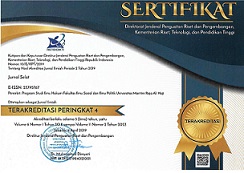Bijak Menggunakan Media Sosial di Kalangan Pelajar Menurut Undang-Undang Nomor 19 Tahun 2016 Tentang Informasi dan Transaksi Elektronik
DOI:
https://doi.org/10.31629/selat.v6i2.1437Keywords:
Legal Awareness, Information and Electronic Transactions, Legal.Abstract
This article will discuss the dangers of hoax news and the legal impact of not being able to use social media wisely. The object of research in this study were students of junior high school and senior high school, based on the results of this study it was found that the students in the two schools were aware that the legal impact in terms of social media abuse, the impact of ITE and also the sanctions obtained if there is abuse of social media and hoax news that is not necessarily true. The basis of this research to take samples in the two schools is because, young people in a condition of thinking that is still very innocent, they would certainly be very easy to be told to spread the chain to other friends or others. We also have to realize that the ability of teenagers in studying and studying is still very minimal, especially if the hoax is boarded with certain interests that are packed with funny videos. At their young age, those who used to look for sensations. There are even some of our children who actually feel proud that their wrongdoing is the center of attention. Some even deliberately become perpetrators or perpetrators' profiles, because they want to be famous and feel great because they dare to make mistakes. The research method used is to use empirical research methods in which the data in this study are directly sought and examined in the field, empirical data analysis techniques, namely data obtained and arranged systematically and analyzed diagnostically and prescriptive in describing data in writing.
References
A. Buku
Burhan Ashofa. Metode Penelitian Hukum. Jakarta: Rineka Cipta, 2007.
Elkind D. Egocentrism In Adolescence. Child Development. 1967.
Setiono. Pemahaman Terhadap Metodologi Penelitian Hukum. Surakarta: Program Studi Ilmu Hukum Pasca Sarjana Universitas Sebelas Maret (UNS), 2010.
B. Jurnal
Mochammad Ali Maulidin, Syahirul Alim dan Viani Puspita Sari. “Cerdas dan Bijak Dalam Memanfaatkan Media Sosial Di Tengah Era Literasi dan Informasi.†Jurnal Aplikasi Ipteks Untuk Masyarakat. Maret 2017: Volume 6. Nomor 1.
Pamela Felita, dkk. “Pemakaian Media Sosial dan Self Concept Pada Remaja.†Jurnal Ilmiah Psikologi MANASA. Mei 2016: Volume 5. Nomor 1.
C. Internet
Erwin, Z. “Indonesia juara akses internet melalui smartphone.†lihat dalam: http://tekno.tempo.co/ IndonesiaJuaraAksesInternetMelaluiSmartphone, diakses pada 25 Mei 2018
Hendra. “Fenomena Internet Pada Anak-Anak dan Remaja.†http://hendra.room318online.com/FenomenaInternetPadaAnak-AnakdanRemaja, diakses pada tanggal 23 Agustus 2018.
Qomariah A.N. “Perilaku Penggunaan Internet Pada Kalangan Remaja di Perkotaan.†http://palimpsest.fisip.unair.ac.id/, diakses pada tanggal 23 Mei 2018.
D. Peraturan Perundang-Undangan
Undang-Undang Republik Indonesia Nomor 19 Tahun 2016 Tentang Perubahan Atas Undang-Undang Republik Indonesia Nomor 11 Tahun 2008 Tentang Informasi dan Transaksi Elektronik.







